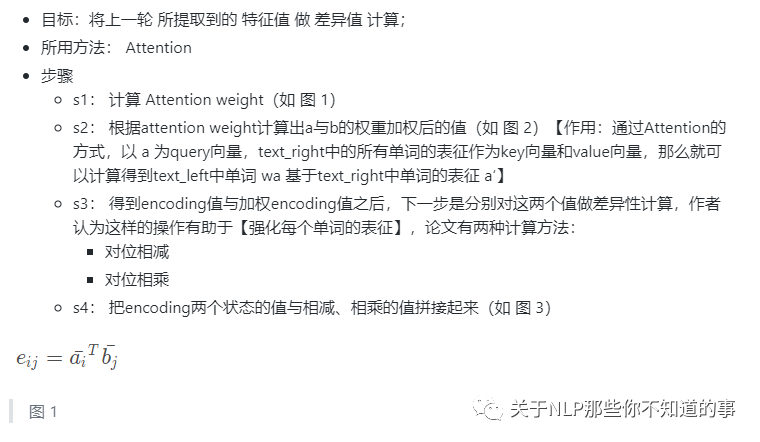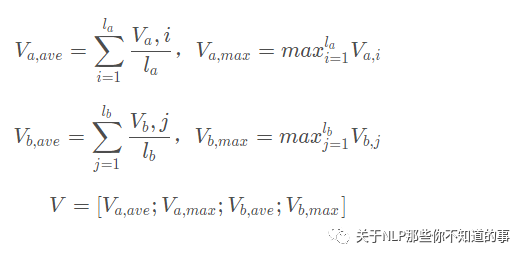作者:杨夕
项目地址:https://github.com/km1994/nlp_paper_study
个人介绍:大佬们好,我叫杨夕,该项目主要是本人在研读顶会论文和复现经典论文过程中,所见、所思、所想、所闻,可能存在一些理解错误,希望大佬们多多指正。
论文:Enhanced LSTM for Natural Language Inference
会议:TACL2017
论文地址:https://arxiv.org/pdf/1609.06038.pdf
目录

一、动机篇
自然语言推理(NLI: natural language inference)问题:
即判断能否从一个前提p中推导出假设h
简单来说,就是判断给定两个句子的三种关系:蕴含、矛盾或无关
在Query 扩召回项目中,通过各种手段挖掘出一批同义词,想对其进行流程化,所以考虑加上语义推断,作为竞赛神器 ESIM 模型,该模型在近两年横扫了好多比赛,算是 NLI (Natural Language Inference) 领域未来几年一个很难绕过的超强 baseline 了,单模型的效果可以达到 88.0% 的 Acc。
创新点
精细的设计序列式的推断结构;
考虑局部推断和全局推断。
二、ESIM 模型篇
2.1 模型介绍

模型整体结构
模型结构图分为左右两边:
左侧就是 ESIM,
右侧是基于句法树的 tree-LSTM,两者合在一起交 HIM (Hybrid Inference Model)。
整个模型从下往上看,分为三部分:
input encoding;
local inference modeling;
inference composition;
Prediction
以 ESIM 为例
2.2 Input Encoding
step1 : 输入一般可以采用预训练好的词向量或者添加embedding层,这里介绍采用的是embedding层;
step2 :采用一个双向的LSTM,起作用主要在于对输入值做encoding,也可以理解为在做特征提取,
step3 :把其隐藏状态的值保留下来,

BiLSTM 公式
其中i与j分别表示的是不同的时刻,a与b表示的是上文提到的p与h。
代码讲解
def forward(self):
# step 1 : input encoding : embeding + BiLSTM
p_embedding = tf.nn.embedding_lookup(self.embedding, self.p)
h_embedding = tf.nn.embedding_lookup(self.embedding, self.h)
with tf.variable_scope("lstm_p", reuse=tf.AUTO_REUSE):
(p_f, p_b), _ = self.bilstm(p_embedding, self.config['embedding_hidden_size'])
with tf.variable_scope("lstm_p", reuse=tf.AUTO_REUSE):
(h_f, h_b), _ = self.bilstm(h_embedding, self.config['embedding_hidden_size'])
p = tf.concat([p_f, p_b], axis=2)
h = tf.concat([h_f, h_b], axis=2)
p = self.dropout(p)
h = self.dropout(h)
...
2.3 Local Inference Modeling


代码
def forward(self):
...
# step 2 : local inference modeling
## 2.1 首先计算两个句子 word 之间的相似度,得到2维的相似度矩阵,这里会用到 torch.matmul
e = tf.matmul(p, tf.transpose(h, perm=[0, 2, 1]))
## 2.2 然后才进行两句话的 local inference。用之前得到的相似度矩阵,结合 a,b 两句话,互相生成彼此相似性加权后的句子,维度保持不变。
a_attention = tf.nn.softmax(e)
b_attention = tf.transpose(tf.nn.softmax(tf.transpose(e, perm=[0, 2, 1])), perm=[0, 2, 1])
a = tf.matmul(a_attention, h)
b = tf.matmul(b_attention, p)
## 2.3 在 local inference 之后,进行 Enhancement of local inference information。这里的 enhancement 就是计算 a 和 align 之后的 a 的差和点积, 体现了一种差异性吧,更利用后面的学习。
m_a = tf.concat((a, p, a - p, tf.multiply(a, p)), axis=2)
m_b = tf.concat((b, h, b - h, tf.multiply(b, h)), axis=2)
...
2.4 Inference Composition
在这一层中,把之前的值再一次送到了BiLSTM中,这里的BiLSTM的作用和之前的并不一样,这里主要是用于捕获局部推理信息 ma 和 mb 及其上下文,以便进行推理组合。
最后把BiLSTM得到的值进行池化操作,分别是最大池化与平均池化,并把池化之后的值再一次的拼接起来。

代码
def forward(self):
...
# step 3 : inference composition
## 3.1 用 BiLSTM 提取上下文信息
with tf.variable_scope("lstm_a", reuse=tf.AUTO_REUSE):
(a_f, a_b), _ = self.bilstm(m_a, self.config['context_hidden_size'])
with tf.variable_scope("lstm_b", reuse=tf.AUTO_REUSE):
(b_f, b_b), _ = self.bilstm(m_b, self.config['context_hidden_size'])
a = tf.concat((a_f, a_b), axis=2)
b = tf.concat((b_f, b_b), axis=2)
a = self.dropout(a)
b = self.dropout(b)
## 3.2 使用 MaxPooling 和 AvgPooling 进行池化操作
a_avg = tf.reduce_mean(a, axis=2)
b_avg = tf.reduce_mean(b, axis=2)
a_max = tf.reduce_max(a, axis=2)
b_max = tf.reduce_max(b, axis=2)
v = tf.concat((a_avg, a_max, b_avg, b_max), axis=1)
...
2.5 Prediction
目标:预测
思路:
s1:把 V 送入到全连接层,激活函数采用的是tanh;
s2:将得到的结果送到softmax层。
代码
def forward(self):
...
# step 4 : 预测
## 4.1 拼接 一个 全连接层
v = tf.layers.dense(v, self.config['hidden'], activation='tanh')
v = self.dropout(v)
logits = tf.layers.dense(v, self.config['class_size'], activation='tanh')
## 4.2 拼接 一个 softmax 层
self.prob = tf.nn.softmax(logits, name="logits")
self.prediction = tf.argmax(logits, axis=1, name="predictions")
self.train(logits)
2.6 模型训练
代码介绍:
def train(self, logits):
y = tf.one_hot(self.y, self.config['class_size'])
# 计算最后一层是softmax层的cross entropy,
# 把softmax计算与cross entropy计算放到一起了,
# 用一个函数来实现,用来提高程序的运行速度。
loss = tf.nn.softmax_cross_entropy_with_logits(labels=y, logits=logits)
self.loss = tf.reduce_mean(loss)
self.train_op = tf.train.AdamOptimizer(self.config['learning_rate']).minimize(self.loss)
correct_prediction = tf.equal(tf.cast(self.prediction, tf.int32), self.y)
self.acc = tf.reduce_mean(tf.cast(correct_prediction, tf.float32))
损失函数介绍
tf.nn.softmax_cross_entropy_with_logits(labels=y, logits=pred, name=None)
函数功能:计算最后一层是softmax层的cross entropy,把softmax计算与cross entropy计算放到一起了,用一个函数来实现,用来提高程序的运行速度。
参数介绍
参数name:该操作的name
参数labels:shape是[batch_size, num_classes],神经网络期望输出。
参数logits:shape是[batch_size, num_classes] ,神经网络最后一层的输入。
参考
文本匹配、文本相似度模型之ESIM
短文本匹配的利器-ESIM







